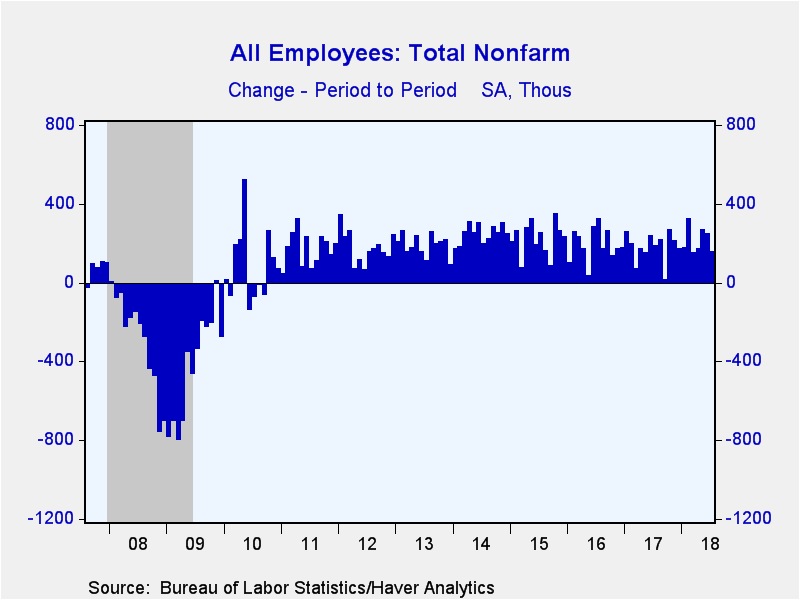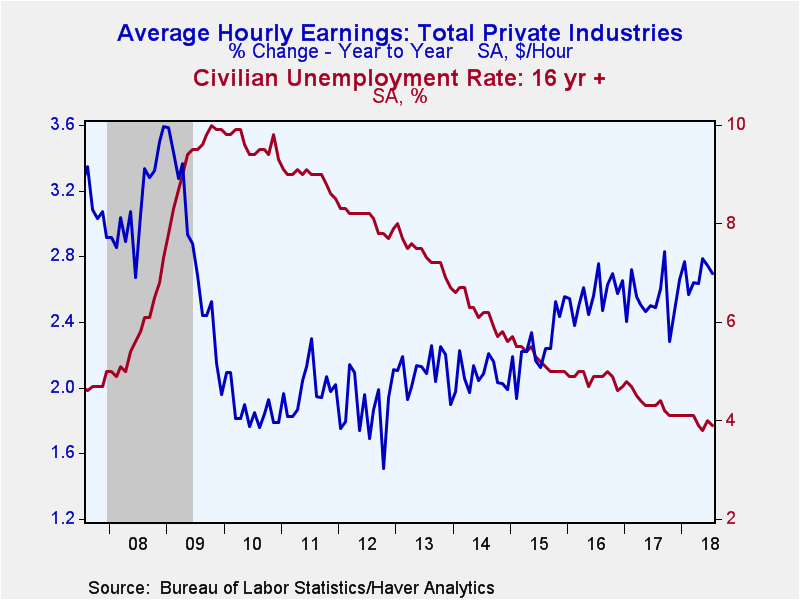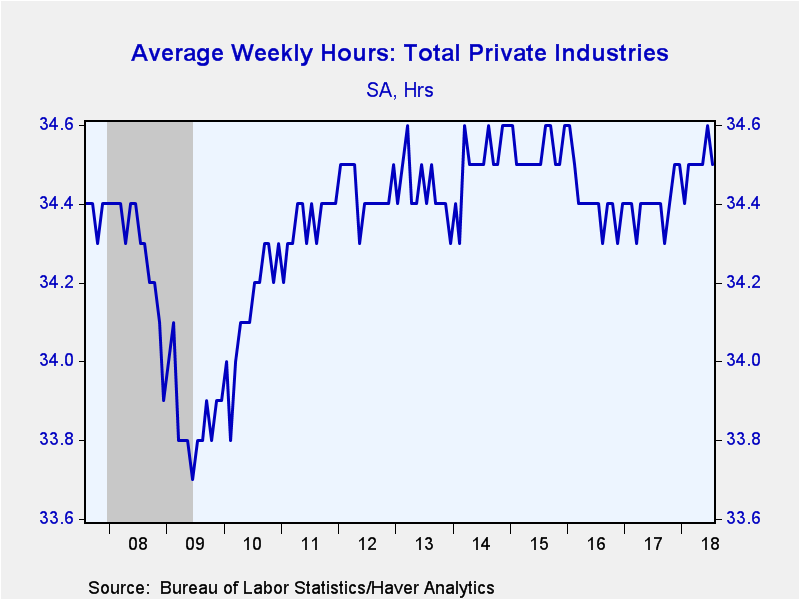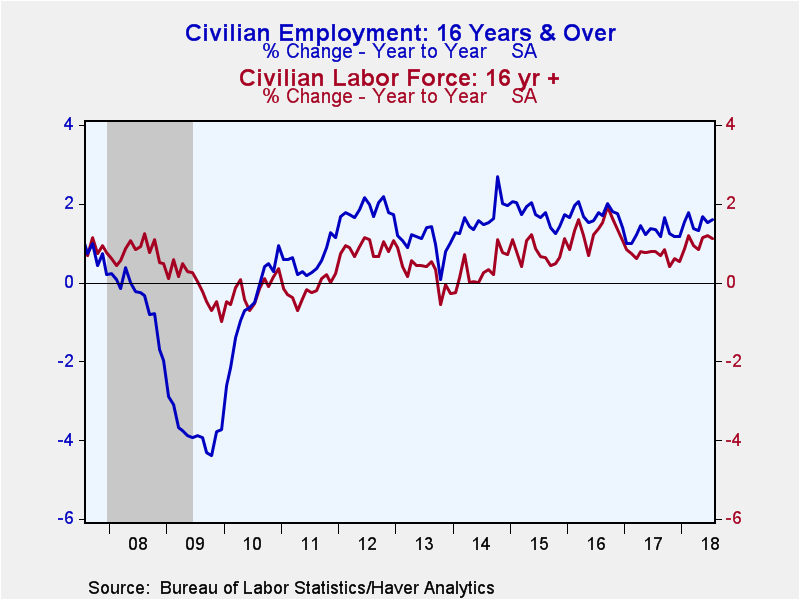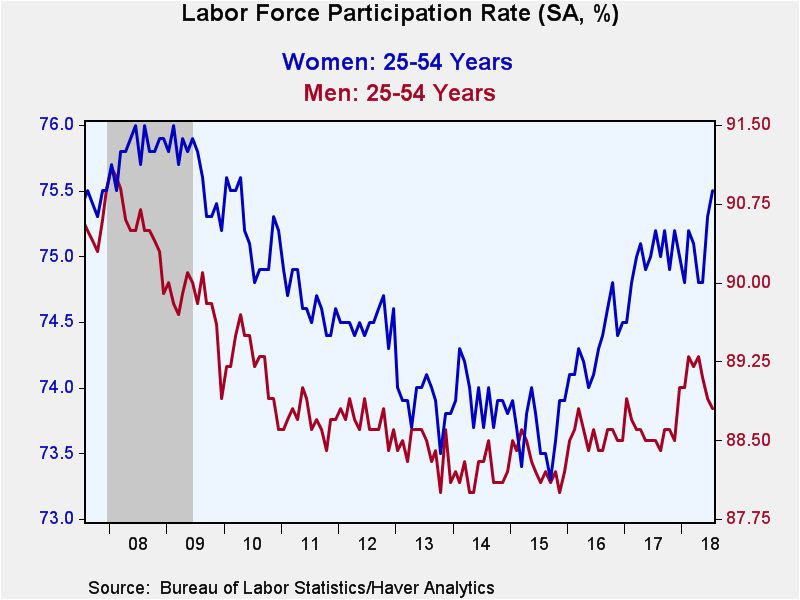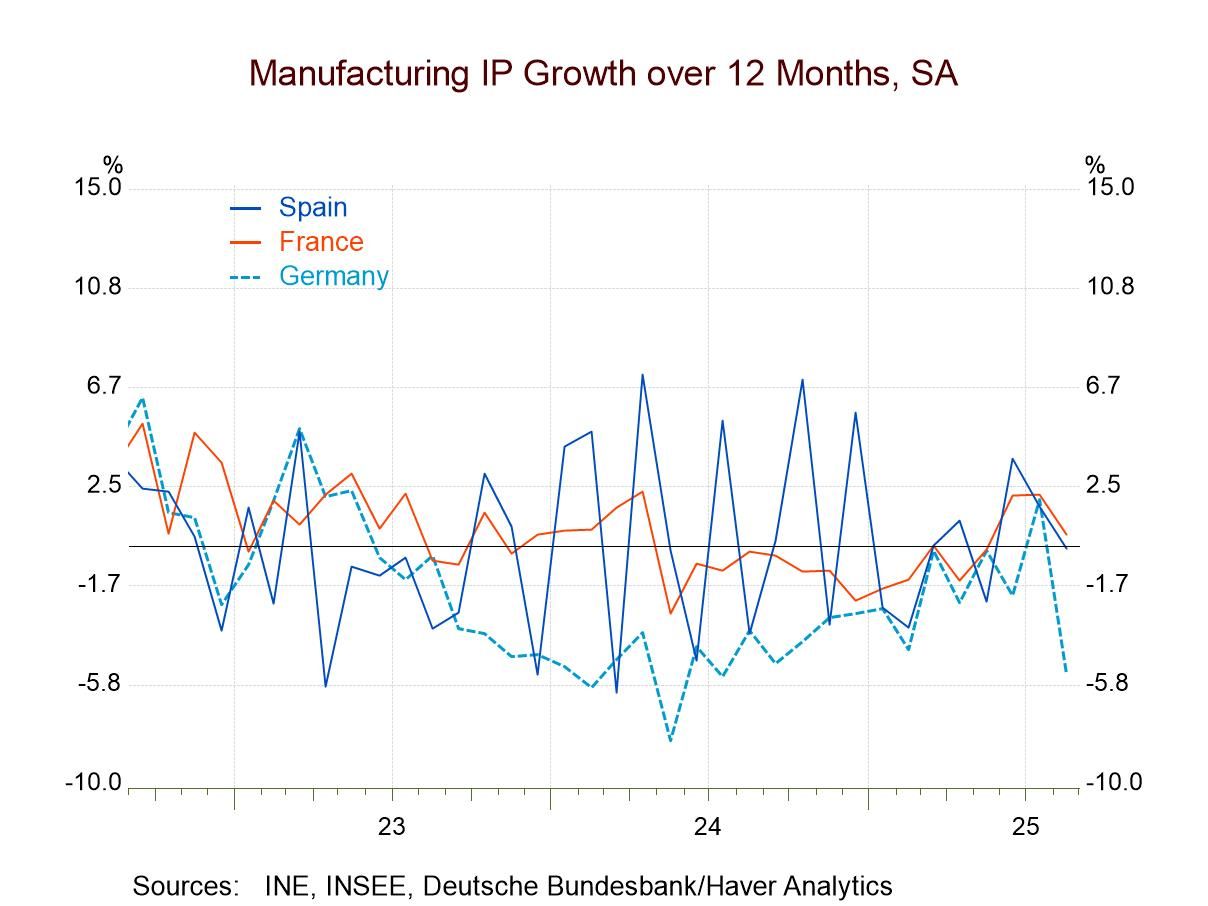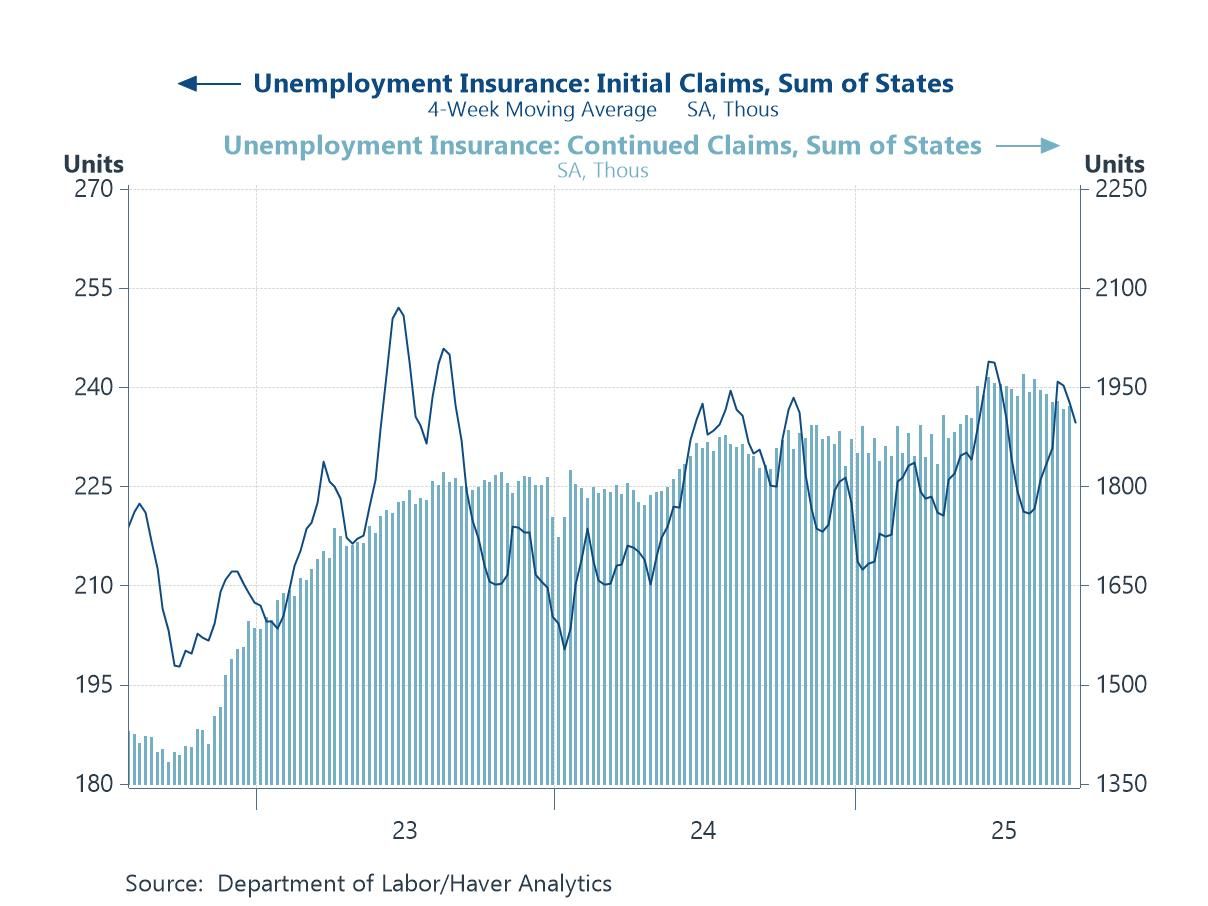 Global| Aug 03 2018
Global| Aug 03 2018U.S. Nonfarm Payroll Employment Growth Moderates, but Jobless Rate Declines and Wages Firm
by:Tom Moeller
|in:Economy in Brief
Summary
Strength in the labor market abated during July. Nonfarm payrolls increased 157,000 (1.6% y/y) following a 248,000 June rise which was revised up from 213,000 estimated last month. The gain in May payrolls also was strengthened to [...]
Strength in the labor market abated during July. Nonfarm payrolls increased 157,000 (1.6% y/y) following a 248,000 June rise which was revised up from 213,000 estimated last month. The gain in May payrolls also was strengthened to 268,000 from 244,000, bringing the two-month revision to +59,000. A 190,000 rise in employment had been expected in the Action Economics Forecast Survey.
Average hourly earnings increased 0.3% (2.7% y/y) as expected, following a downwardly revised 0.1% rise.
The unemployment rate slipped to an expected 3.9% due to a surge in employment. The total unemployment rate, including those marginally attached and working part-time for economic reasons, fell to 7.5%, the lowest level since May 2001.
Growth in nonfarm payrolls last month of 157,000 disappointed expectations and was the weakest increase since March. Softness centered in the private service-producing sector where the 118,000 payroll increase (1.6% y/y) was well below the high of 239,000 in September 2017. Much of that slowdown occurred in the leisure & hospitality sector where payrolls gained 40,000 (1.6% y/y), although recent monthly increases have been steady & firm. Jobs in education & health services rose a weakened 22,000 (1.8% y/y), the smallest rise in nine months. Professional & business services jobs rose a steady 51,000 (2.6% y/y), including a strengthened 27,900 increase (3.3% y/y) in temporary help jobs. Jobs in trade, transportation & utilities rose a weakened 15,000 (1.2% y/y), including a slim 7,000 rise (0.6% y/y) in retail trade employment. Financial sector employment fell 5,000 (+1.3% y/y).
Another source of weakness in payroll employment was the government sector where payrolls declined 13,000 and were roughly unchanged y/y. Local government jobs declined 20,000 (+0.1% y/y). State government employment rose 5,000 (-0.3% y/y) and federal government jobs rose 2,000 (-0.3% y/y).
Manufacturing sector employment rose 37,000 (2.6% y/y), the strongest increase since December. Construction sector jobs gained 19,000 (4.2% y/y), down sharply from the Q4'17 and Q1'18 increases. Employment in the mining sector fell 3,800 (+8.9% y/y) after a 7,300 June rise.
Average hourly earnings increased 0.3%, but the downward revision to June's increase left the y/y increase stable at 2.7%. Sources of strength in earnings growth can be found in the financial services (4.8% y/y) and leisure & hospitality (3.2% y/y) sectors. Construction sector earnings grew an improved 3.2% y/y but the 1.3% y/y rise in factory sector pay was reduced versus 2.2% last year and 3.0% in 2016. Moderate earnings growth occurred in education & health services (2.5%) and information (2.4% y/y) sectors. For production and non-supervisory workers a 0.1% m/m increase followed stronger gains earlier in the year. The 2.7% y/y change was elevated from growth late last year.
The length of the average workweek eased to 34.5 hours but remained elevated versus earlier lows. Mining & logging sector hours remained firm at 46.1, factory sector hours held steady at 40.9 and construction hours were fairly steady at 39.4. Private service sector hours of 33.3 were reduced as education & health services hours fell to 32.9. Professional & business services hours held at 36.2, but leisure & hospitality hours eased to 26.1.
From the household sector survey, the decline in the unemployment rate to 3.9% reflected a 389,000 increase in employment and a 105,000 rise in the labor force. The labor force participation rate held steady at 62.9%. The rate for those aged 25-54 was elevated at 82.1%, 88.8% for men and 75.5% for women. The average duration of unemployment rose slightly to 23.2 weeks but the medium duration jumped to 9.5 weeks.
By educational attainment, the unemployment rate for those with less than a high school diploma of 5.1% compared to 4.0% for high school graduates, but no college. Individuals with some college but no degree were 3.2% unemployed and college graduates were 2.2% without work.
The teenage unemployment rate rose to 13.1% while for those aged 20-24 years old, it fell to 6.9%. The jobless rate for those aged 25-54 years old, it eased to 3.2%, and for individuals over age 55, the rate was steady at 3.1%.
The labor market data are contained in Haver's USECON database. Detailed figures are in the EMPL and LABOR databases. The expectations figures are in the AS1REPNA database.
| Employment: (SA, M/M Change, 000s) | Jul | Jun | May | Jul Y/Y | 2017 | 2016 | 2015 |
|---|---|---|---|---|---|---|---|
| Payroll Employment | 157 | 248 | 268 | 1.6% | 1.6% | 1.8% | 2.1% |
| Previous Estimate | -- | 213 | 244 | -- | -- | -- | -- |
| Manufacturing | 37 | 33 | 23 | 2.6 | 0.7 | 0.1 | 1.2 |
| Construction | 19 | 13 | 30 | 4.2 | 3.4 | 4.1 | 5.0 |
| Private Service-Producing | 118 | 182 | 204 | 1.6 | 1.8 | 2.2 | 2.4 |
| Government | -13 | 14 | 8 | 0.0 | 0.4 | 0.9 | 0.7 |
| Average Weekly Hours - Private Sector | 34.5 | 34.6 | 34.5 | 34.4 | 34.4 | 34.4 | 34.5 |
| Private Sector Average Hourly Earnings (%) | 0.3 | 0.1 | 0.3 | 2.7 | 2.5 | 2.6 | 2.3 |
| Unemployment Rate (%) | 3.9 | 4.0 | 3.8 | 4.3 | 4.4 | 4.9 | 5.3 |
Tom Moeller
AuthorMore in Author Profile »Prior to joining Haver Analytics in 2000, Mr. Moeller worked as the Economist at Chancellor Capital Management from 1985 to 1999. There, he developed comprehensive economic forecasts and interpreted economic data for equity and fixed income portfolio managers. Also at Chancellor, Mr. Moeller worked as an equity analyst and was responsible for researching and rating companies in the economically sensitive automobile and housing industries for investment in Chancellor’s equity portfolio. Prior to joining Chancellor, Mr. Moeller was an Economist at Citibank from 1979 to 1984. He also analyzed pricing behavior in the metals industry for the Council on Wage and Price Stability in Washington, D.C. In 1999, Mr. Moeller received the award for most accurate forecast from the Forecasters' Club of New York. From 1990 to 1992 he was President of the New York Association for Business Economists. Mr. Moeller earned an M.B.A. in Finance from Fordham University, where he graduated in 1987. He holds a Bachelor of Arts in Economics from George Washington University.


